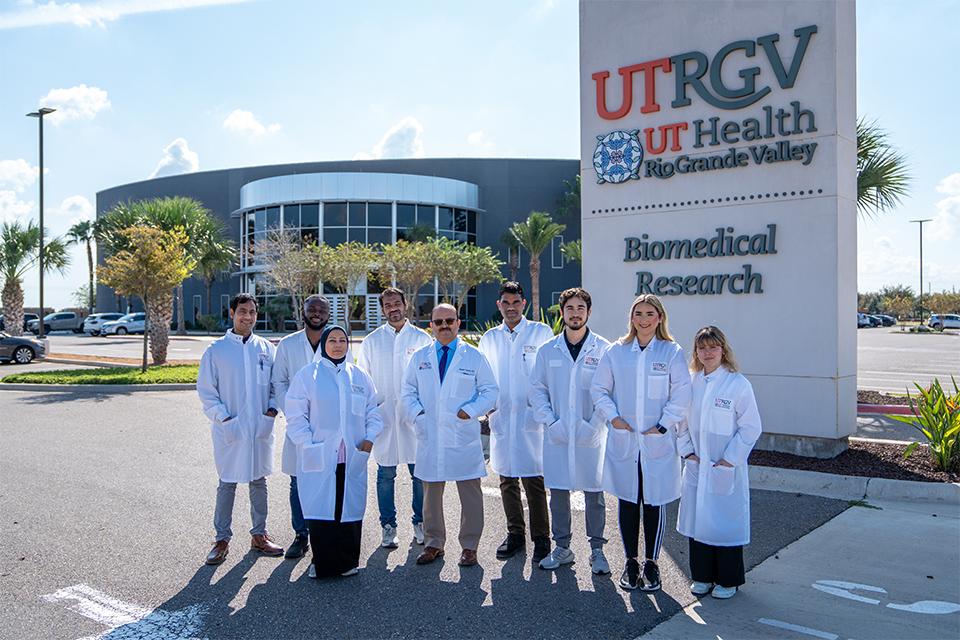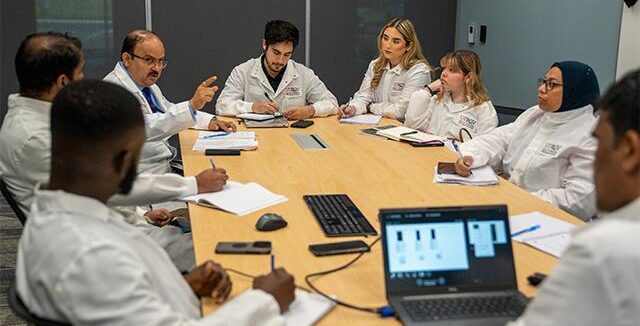UTRGV School of Medicine team reveals breakthrough in cancer cell survival
Students make significant contributions to cancer studies
Photo above: Dr. Manish Tripathi, assistant professor in the Division of Cancer and Immunology at the UTRGV School of Medicine, and his team are making essential contributions to the fight against cancer. Pictured (Left to Right): Dr. Mohammed Shabir Hussain, postdoctoral fellow, Dennis Kwabiah, MSBCMB student, Walaa Abbas, MSBCMB student, Dr. Salique Hassan Shaham, postdoctoral fellow, Dr. Manish K. Tripathi, Dr. Veerababu Nagati, postdoctoral fellow, Ricardo Pequeno Bracho, MSBCMB student, Mariana Barragan, research volunteer, and Yamile Abuchard Anaya, research assistant/lab manager (UTRGV Photo by Heriberto Perez-Zuniga)

By Heriberto Perez-Zuniga, UTRGV Communications
EDINBURG, TEXAS – JAN. 22, 2025 – The fight against cancer is making strides globally, but some of the most important breakthroughs are happening locally in the Rio Grande Valley.
At the UTRGV School of Medicine’s South Texas Center of Excellence in Cancer Research, Dr. Manish Tripathi, assistant professor in immunology and microbiology at the UTRGV School of Medicine, and his team are breaking new ground in understanding how cancer cells survive and spread.
Their research focuses on long non-coding RNAs (lncRNAs) and their role in regulating glucose metabolism, a key pathway for cancer cell survival and metastasis.
“Cancer cells rely heavily on glucose metabolism, often using it to evade treatments and thrive under harsh conditions,” Tripathi said. “By identifying specific lncRNAs that regulate this pathway, we aim to disrupt cancer cells’ energy supply, limiting their growth and ability to spread.”
Tripathi said this research, funded through grant support from the National Institutes of Health (NIH) and the Cancer Prevention Research Institute of Texas (CPRIT), can potentially develop new treatment strategies for aggressive cancers, such as liver and colorectal.
Photo above: Dr. Tripathi aims to lead groundbreaking research in the fight against cancer. His work focuses on understanding the role of long non-coding RNAs (lncRNAs) in regulating glucose metabolism, a crucial pathway that cancer cells exploit to survive and spread. This research promises to improve treatment strategies for aggressive cancers like liver and colorectal, especially in underserved populations such as those in the Rio Grande Valley. (UTRGV Photo by Heriberto Perez-Zuniga)

A CRITICAL LIFELINE
The National Institutes of Health finds that cervical cancer incidence and mortality rates are approximately 55% higher in the Valley – which faces socioeconomic challenges and limited healthcare access – contributing to significant cancer health disparities compared to national averages.
This research could offer a critical lifeline as cancer remains a leading cause of death in Texas.
Support for the region is growing thanks to groundbreaking research like this and the upcoming UT Health RGV Cancer and Surgery Center, slated to open this year.
The state-of-the-art $145 million facility will provide the space for advancing research into new cancer treatments and improving patient outcomes for those battling the disease.
Tripathi said the research being conducted today in the Valley has the potential to transform cancer treatment strategies worldwide.
“By understanding the factors driving stress-associated cancer progression and drug resistance, particularly liver cancers which is among the most prevalent in the Valley, we can develop targeted treatments that reduce metastasis and improve outcomes for underserved patients,” said Tripathi. “This work can lead to new, more effective therapies tailored to our community’s needs.”
NEXT GENERATION
This research also aims to advance the fight against cancer and empower the next generation of scientists through mentorship and hands-on experience.
“Currently, my research team includes three students who are making important contributions, and I’m proud to help them reach their academic potential,” said Tripathi.
Ricardo Pequeño Bracho, a UTRGV student pursuing a Master of Science in Biochemistry and Molecular Biology and part of Tripathi’s research team, credits his experiences in Tripathi’s lab with shaping his academic and professional growth.
Bracho grew up in the Rio Grande Valley and witnessed the region’s healthcare challenges firsthand.
“I saw how many people delay seeking healthcare because they simply can’t afford it or find it too expensive,” Bracho said. “That fueled my motivation to pursue a medical career. Our research provides valuable insight into therapies that could combat cancer progression and metastasis, especially for at-risk populations in South Texas.”
Bracho has presented the lab’s findings at the UTRGV School of Medicine research conferences and plans to showcase their latest work at the American Association for Cancer Research (AACR) in April. The AACR is the largest cancer research organization in the country and brings together researchers from all around the world to discuss the latest advancements in cancer treatment and prevention.
Dr. Michael Hocker, UTRGV School of Medicine dean and senior vice president for UT Health RGV, said these opportunities highlight the school’s commitment to fostering a new generation of scientists to address local healthcare challenges.
“There is a shortage of doctors not only in the Valley but across Texas, and we owe it to our community to help bridge that gap,” Hocker said. “By providing hands-on research experiences and mentorship, we’re ensuring that the next generation of medical professionals is well-equipped to make a lasting impact on the health of our region.”
Looking ahead, Tripathi’s team aims to translate their findings into clinical applications, targeting metabolic vulnerabilities in cancer cells to develop more effective treatments.
“Every breakthrough we achieve in the lab brings us closer to reducing cancer-related mortality and health disparities in the RGV,” Tripathi said. “And just as importantly, we are building a pipeline of young scientists who will carry this work forward and make a lasting impact on our community.”

